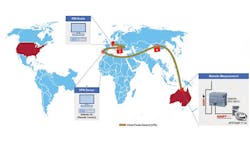The HART protocol was first released to the control and instrumentation community back in the late 1980s, when a common digital communications protocol for so called “smart” instruments was envisioned to unify the proprietary efforts of the major instrumentation and control system suppliers.
So began HART’s push to establish and preserve the interoperability among various suppliers’ products that end users had come to expect from their strictly analog instruments—a central mission for the digital age that continues in the work of FieldComm Group. Throughout HART’s various incarnations that were yet to come, the HART protocol maintains what has become the industry’s best example of ecosystem interoperability among different suppliers’ devices and systems.
The original HART protocol still communicates via a digital signal superimposed on the 4-20mA analog instrumentation current loops first standardized in the 1950s. Today, tens of millions of 4-20mA HART instruments constitute the vast majority of instruments installed around the world. Even today, it dominates shipments of new instruments to the global process industries.
So, when the need to connect wireless sensors arose in the 2000s, industry called on HART once again, this time implemented over a wireless mesh network as WirelessHART. But once gathered at a WirelessHART access point, there was a need to transmit move that data onto the plant’s Ethernet-based control and information infrastructure. So was born HART-IP, which was simply the long-trusted HART “application layer” protocol, this time deployed over the Internet Protocol (IP) network-layer on Ethernet.
Enabling digital transformation
The leap to Ethernet has positioned HART to continue to lead the process industry’s ongoing digital transformation in two very important ways.
First, with Ethernet-APL now providing intrinsically safe, two-wire, 10-Mbps field communications at the device level (see companion article on p16), HART-IP is positioned to enable the high-speed, high-power field communications revolution that Ethernet-APL promises, while also preserving the familiar tools and established work processes of instrumentation techs and control engineers worldwide.
At the field level, today’s HART-IP paired with Ethernet-APL replaces the 4-20mA analog signal used for process variables with an all-digital signal. It also now includes a standardized methodology for writing instructions to final control elements. In short, HART functionality is no longer limited to monitoring and diagnostics—with HART-IP it does control, too. Tests performed on Ethernet-APL indicate bandwidth that is more than sufficient for closing the loop on most process control applications. (Visit go.fieldcommgroup.org/HART-IP-Control to download paper.) For example, even with 150 devices reporting 20 updates per second over a 10 Mbps segment, only 30% of available bandwidth was consumed. Version 7.7 of the HART standard also includes an integrated security model for HART-IP, paving the way for a proper cybersecurity posture on the coming generation of Ethernet-APL field devices.
The second way in which HART-IP is helping to advance industry’s digital transformation, is to securely communicate HART data out to enterprise systems and cloud-based Industrial IoT applications to help analyze and benchmark performance across units, sites and entire enterprises. A growing number of progressive process manufacturers already are using multiplexer technology to extract all that rich, digital HART data from their 4-20mA analog loops—and are using that data to effectively advance their digital transformation initiatives.
Increasingly, digital transformation of operations entails performance-driven analytics and prescriptive maintenance enabled by HART data. HART-IP also facilitates secure communications with enterprise systems and private or public cloud services, such as AWS, Microsoft Azure and Google Cloud. Here, HART-IP complements IIoT technologies such as MQTT, AMQT, JSON
and OPC UA.
And as HART-IP usage spreads to field networks and up into enterprise systems and the cloud, that access will only be simpler, faster and easier.
About the Author
FieldComm Group
FieldComm Group

Leaders relevant to this article:

